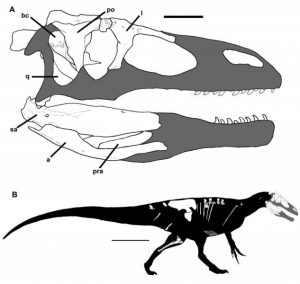
A new species of megaraptorid dinosaur discovered in Patagonia may help discern the evolutionary origins of the megaraptorid clade, according to a study published July 20, 2016 in the open-access journal PLOS ONE by Rodolfo Coria from the Consejo Nacional de Investigaciones Científicas y Técnicas, Argentina, and Phillip Currie from the University of Alberta, Canada.
The Patagonian region of Argentina has previously proven to be rich in fossils from the Late Cretaceous epoch, including a number of megaraptorids, a clade whose carnivorous diet gave rise to their name meaning ‘giant thieves’. These medium-sized theropod dinosaurs, including South American genera Megaraptor, Orkoraptor, and Aerosteon as well as genera from Australia and Japan, have characteristically large claws and air-filled, birdlike bones.
The fossilized partial skeleton of a megaraptorid dinosaur analyzed in this study was discovered in Sierra Barrosa, in northwest Patagonia and represents one of the most complete megaraptorids found, with an unusually intact braincase. With unique skull features, the dinosaur, which they named Murusraptor barrosaensis, is a new species in the megaraptorid clade. This specimen appears to be immature, but the authors suggest that the species is larger and slenderer than Megaraptor and comparable in size with Aerosteon and Orkoraptor. While sharing many features with the other species, Musuraptor has distinctive facial features not previously seen amongst megaraptorids, as well as unusually shaped hip bones.
While phylogenetic analysis could not clearly determine evolutionary relationships, the authors note that these fossils provide new anatomical information which might help to resolve current debates as to whether the megaraptorids are a clade of the allosauroid or the coelurosaurid theropods.
As lead author Rodolfo Coria states: “A new meat-eating dinosaur, Murusraptor barrosaensis, has been discovered from 80 million years old rocks from Patagonia, Argentina. Although incomplete, the beautifully preserved bones of Murusraptor unveil unknown information about the skeletal anatomy of megaraptors, a highly specialized group of Mesozoic predators.”
Reference:
Rodolfo A. Coria, Philip J. Currie. A New Megaraptoran Dinosaur (Dinosauria, Theropoda, Megaraptoridae) from the Late Cretaceous of Patagonia. PLOS ONE, 2016; 11 (7): e0157973 DOI: 10.1371/journal.pone.0157973
Note: The above post is reprinted from materials provided by PLOS.










